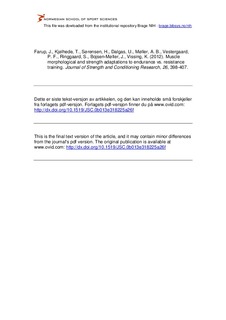| dc.contributor.author | Farup, Jean | |
| dc.contributor.author | Kjølhede, Tue | |
| dc.contributor.author | Sørensen, Henrik | |
| dc.contributor.author | Dalgas, Ulrik | |
| dc.contributor.author | Møller, Andreas B. | |
| dc.contributor.author | Vestergaard, Poul F. | |
| dc.contributor.author | Ringgaard, Steffen | |
| dc.contributor.author | Bojsen-Møller, Jens | |
| dc.contributor.author | Vissing, Kristian | |
| dc.date.accessioned | 2013-02-01T12:19:27Z | |
| dc.date.accessioned | 2013-02-02T04:05:38Z | |
| dc.date.available | 2013-02-01T12:19:27Z | |
| dc.date.available | 2013-02-02T04:05:38Z | |
| dc.date.issued | 2012 | |
| dc.identifier.citation | Journal of Strength and Conditioning Research. 2012, 26, 398-407 | |
| dc.identifier.issn | 1064-8011 | |
| dc.identifier.uri | http://hdl.handle.net/11250/171056 | |
| dc.description | I Brage finner du siste tekst-versjon av artikkelen, og den kan inneholde ubetydelige forskjeller fra forlagets pdf-versjon. Forlagets pdf-versjon finner du på ovidsp.uk.ovid.com: http://dx.doi.org/10.1519/JSC.0b013e318225a26f / In Brage you'll find the final text version of the article, and it may contain insignificant differences from the journal's pdf version. The definitive version is available at ovidsp.uk.ovid.com: http://dx.doi.org/10.1519/JSC.0b013e318225a26f | |
| dc.description.abstract | Fascicle angle (FA) is suggested to increase as a result of fiber hypertrophy and furthermore to serve as the explanatory link in the discrepancy in the relative adaptations in the anatomical cross-sectional area (CSA) and fiber CSA after resistance training (RT). In contrast to RT, the effects of endurance training on FA are unclear. The purpose of this study was therefore to investigate and compare the longitudinal effects of either progressive endurance training (END, n = 7) or RT (n = 7) in young untrained men on FA, anatomical CSA, and fiber CSA. Muscle morphological measures included the assessment of vastus lateralis FA obtained by ultrasonography and anatomical CSA by magnetic resonance imaging of the thigh and fiber CSA deduced from histochemical analyses of biopsy samples from m. vastus lateralis. Functional performance measures included [latin capital V with dot above]O2max and maximal voluntary contraction (MVC). The RT produced increases in FA by 23 +/- 8% (p < 0.01), anatomical CSA of the knee extensor muscles by 9 +/- 3% (p = 0.001), and fiber CSA by 19 +/- 7% (p < 0.05). RT increased knee extensor MVC by 20 +/- 5% (p < 0.001). END increased [latin capital V with dot above]O2max by 10 +/- 2% but did not evoke changes in FA, anatomical CSA, or in fiber CSA. In conclusion, the morphological changes induced by 10 weeks of RT support that FA does indeed serve as the explanatory link in the observed discrepancy between the changes in anatomical and fiber CSA. Contrarily, 10 weeks of endurance training did not induce changes in FA, but the lack of morphological changes from END indirectly support the fact that fiber hypertrophy and FA are interrelated. | |
| dc.language.iso | eng | |
| dc.publisher | NSCA | |
| dc.subject | fascicle angle | |
| dc.subject | pennation angle | |
| dc.subject | fiber cross-sectional area | |
| dc.subject | anatomical cross-sectional area | |
| dc.subject | cycling | |
| dc.subject | hypertrophy | |
| dc.title | Muscle morphological and strength adaptations to endurance vs. resistance training | |
| dc.type | Journal article | |
| dc.type | Peer reviewed | |
| dc.subject.nsi | VDP::Social science: 200::Social science in sports: 330::Other subjects within physical education: 339 | |
| dc.source.pagenumber | 398-407 | |
| dc.source.volume | 26 | |
| dc.source.journal | Journal of Strength and Conditioning Research | |
| dc.source.issue | 2 | |
| dc.identifier.doi | 10.1519/JSC.0b013e318225a26f | |
